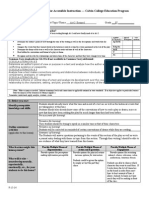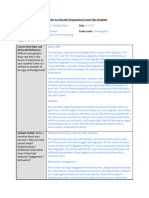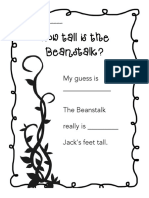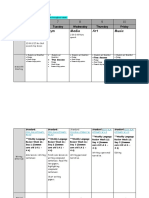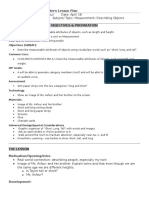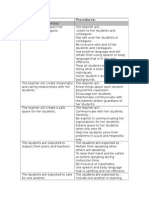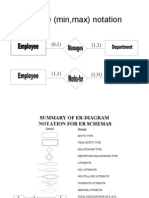Lesson Planning Form For Accessible Instruction - Calvin College Education Program
Lesson Planning Form For Accessible Instruction - Calvin College Education Program
Uploaded by
api-300180062Copyright:
Available Formats
Lesson Planning Form For Accessible Instruction - Calvin College Education Program
Lesson Planning Form For Accessible Instruction - Calvin College Education Program
Uploaded by
api-300180062Original Title
Copyright
Available Formats
Share this document
Did you find this document useful?
Is this content inappropriate?
Copyright:
Available Formats
Lesson Planning Form For Accessible Instruction - Calvin College Education Program
Lesson Planning Form For Accessible Instruction - Calvin College Education Program
Uploaded by
api-300180062Copyright:
Available Formats
Lesson Planning Form for Accessible Instruction Calvin College Education Program
Teacher
Amanda Asfour
Date
Subject/ Topic/ Theme
Fluency
Grade ___First_____________
I. Objectives
How does this lesson connect to the unit plan?
Connects to previous lesson in which we worked on H brothers. Student struggled differentiating between different H brothers.
cognitiveR U Ap An E C*
Learners will be able to:
physical
development
socioemotional
Accurately read first grade Dolch/sight words.
Recognize Dolch/sight words at the first grade level in a game of BINGO.
Recognize the difference between using expression and not in a read-aloud.
Use expression while reading.
Identify words with ch blends in a text.
Make a list of words containing ch from a text.
Common Core standards (or GLCEs if not available in Common Core) addressed:
(Note: Write as many as needed. Indicate taxonomy levels and connections to applicable national or state standards. If an objective applies to particular learners
write the name(s) of the learner(s) to whom it applies.)
*remember, understand, apply, analyze, evaluate, create
II. Before you start
Identify prerequisite
knowledge and skills.
Pre-assessment (for learning):
Fill out a Rasinkski rubric while student reads a level A reader.
Outline assessment
activities
(applicable to this lesson)
Formative (for learning):
Take note of words that the student struggles to pronounce in each activity.
Formative (as learning):
Ask student, what is one thing you learned today? What was your favorite thing we did today?
Summative (of learning):
Provide Multiple Means of
Representation
Provide options for perceptionmaking information perceptible
Provide Multiple Means of
Action and Expression
Provide options for physical
action- increase options for
interaction
Provide Multiple Means of
Engagement
Provide options for recruiting
interest- choice, relevance, value,
authenticity, minimize threats
Provide options for language,
mathematical expressions, and
symbols- clarify & connect
language
Provide options for expression and
communication- increase medium
of expression
Provide options for sustaining
effort and persistence- optimize
challenge, collaboration, masteryoriented feedback
Provide options for
comprehension- activate, apply &
highlight
Provide options for executive
functions- coordinate short & long
term goals, monitor progress, and
modify strategies
Provide options for self-regulationexpectations, personal skills and
strategies, self-assessment &
reflection
What barriers might this
lesson present?
What will it take
neurodevelopmentally,
experientially,
emotionally, etc., for your
students to do this
lesson?
Materials-what materials
(books, handouts, etc) do
you need for this lesson
and are they ready to
use?
1-19-13
Wahoo! Elementary by Hudson Harrison & Bean, BINGO, BINGO markers/chips, expression flash
cards, 2 blank papers, coloring supplies, level A, B, and C readers, running records B and C, Rasinski
Rubric
How will your classroom
be set up for this lesson?
III. The Plan
Time
Components
Motivation
(opening/
introduction/
engagement)
Development
(the largest
component or
main body of
the lesson)
Describe teacher activities
AND
student activities
for each component of the lesson. Include important higher order thinking questions and/or
prompts.
1. Ask student, how are you? Whats new? What 1. Student chats with the teacher about how he/she
have you learned this week?
is doing, what is new, and what he/she has learned.
2.
3.
4.
5.
6.
7.
8.
1-19-13
Start by filling out the rasinki rubric while
student reads A leveled reader from readingaz.
Perform running records while student reads
B and C leveled readers from readinga-z in
order to confirm students reading level.
Practice reading accuracy with first grade
dolch/sight words on the BINGO card. Have
student read each word aloud. If the student
cannot pronounce a word, take note, and help
him/her to pronounce it correctly.
Play sight word BINGO. Teacher calls out
sight words from the BINGO card and student
tries to get five words in a row, column, or
diagonally. When he/she gets a BINGO, have
him/her read the list of words out loud.
Introduce vocabulary from the poem by
asking if the student knows what these words
mean? If not, explain, and use it in a sentence.
Creature an imaginary or very strange
animal.
Maniac a person who is very wild or
crazy.
Read aloud the poem The Creature on the
Teachers Back from the poetry book
Wahoo! Elementary, by Hudson Harrison
and Bean. Before reading, tell the student that
you will read it twice, and to pay attention for
any differences in the way you read. Read one
time using no expression, and a second time
using expression. Ask student, which one did
you like better? Why? What was I doing
differently? Explain that when reading using
expressions, like I did the second time, it is a
lot more fun for the listener and it helps the
reader to understand the text better.
Give the student a chance to read using
expression with flash cards. One pile of
flashcards has first grade appropriate
sentences on it, and the other pile has different
forms of expression. The student should draw
one card from each pile, and read the sentence
2.
Student reads level A reader.
3. Student reads level B and C readers.
4. Student reads the sight words on the BINGO
card.
5. Student plays sight word BINGO while the
teacher calls out words. The goal of the game is to
get five sight words in a row, column, or diagonal.
6. Student answers whether or not he/she knows
the vocabulary words.
7. Student listens for differences in the two
readings. Answers if he/she noticed anything.
8. Student practices reading with expression using
the flashcards. One set has practice sentences, the
other has different ways of reading.
card using the form of expression on the other
card.
For example, read, The cat is in the
tree, with the expression of a monster.
9. Next, go back to The Creature on the
Teachers Back poem. Have the student look
through the poem and find any words that
have the ch blend. Have the student make a
list of these words.
10. Have the student write a sentence using one of
the words from the list and then draw a
picture to illustrate his/her sentence.
Closure
(conclusion,
culmination,
wrap-up)
11. To wrap up the lesson, ask the student what he
or she learned that day and he or she enjoyed
doing that day in order to learn. the students
preferred learning style.
9. Student looks for words with the ch blend in
The Creature on the Teachers Back. He/she
makes a list of any words he/she finds.
10. Student writes a sentence using a word from
the list and then draws a picture to illustrate it.
11. Student tells what he or she learned and
enjoyed doing that day.
Your reflection about the lesson, including evidence(s) of student learning and engagement, as well as ideas for
improvement for next time. (Write this after teaching the lesson, if you had a chance to teach it. If you did not teach this lesson,
focus on the process of preparing the lesson.)
1-19-13
You might also like
- Lola Plants A Garden-Shared Reading PlanDocument6 pagesLola Plants A Garden-Shared Reading Planapi-302553488No ratings yet
- Indirect Instruction Lesson PlanDocument6 pagesIndirect Instruction Lesson Planapi-491426678100% (1)
- Figurative Language Lesson PlanDocument5 pagesFigurative Language Lesson Planapi-333299157No ratings yet
- Shellnutt Lesson Plan 4Document5 pagesShellnutt Lesson Plan 4api-341480465No ratings yet
- Ecological InventoryDocument2 pagesEcological Inventoryapi-300180062No ratings yet
- Bishop Oconnell-School Profile 2018-19Document4 pagesBishop Oconnell-School Profile 2018-19api-305066699No ratings yet
- Sop For MSC Computer Science With Placement To BedsDocument3 pagesSop For MSC Computer Science With Placement To Bedspradeep reddyNo ratings yet
- Lesson Planning Form For Accessible Instruction - Calvin College Education ProgramDocument3 pagesLesson Planning Form For Accessible Instruction - Calvin College Education Programapi-300180062No ratings yet
- Compound WordsDocument15 pagesCompound WordsJulie Ann GacaNo ratings yet
- 477 Lesson Plan Summer 2013Document12 pages477 Lesson Plan Summer 2013tddhondtNo ratings yet
- Read Aloud Lesson PlanDocument6 pagesRead Aloud Lesson Planapi-349922174No ratings yet
- Word StudyDocument8 pagesWord Studyapi-207064250No ratings yet
- Ira - Lesson Plan and ReflectionDocument3 pagesIra - Lesson Plan and Reflectionapi-549465630No ratings yet
- Elvana - Xhakollari - Stage O-Read Aloud - Segmenting Syllables-Lesson Plan-FinalDocument5 pagesElvana - Xhakollari - Stage O-Read Aloud - Segmenting Syllables-Lesson Plan-Finalapi-582193730No ratings yet
- MGR Framework For ml3Document5 pagesMGR Framework For ml3api-403388857No ratings yet
- Lesson Number FiveDocument3 pagesLesson Number Fiveapi-284181679No ratings yet
- Rano MaqolaDocument6 pagesRano MaqolabarnoshukurullayevaNo ratings yet
- Edu 305 Parts of Speech Lesson PlanDocument3 pagesEdu 305 Parts of Speech Lesson Planapi-342432899No ratings yet
- Lesson Plan Sample Co-Teaching Lesson Plan (Direct Instruction) Teachers: Subject: 3 StandardDocument5 pagesLesson Plan Sample Co-Teaching Lesson Plan (Direct Instruction) Teachers: Subject: 3 Standardapi-270184953No ratings yet
- Lesson Planning Form For Accessible Instruction - Calvin College Education ProgramDocument4 pagesLesson Planning Form For Accessible Instruction - Calvin College Education Programapi-300180062No ratings yet
- MGR Framework For ml3 1Document6 pagesMGR Framework For ml3 1api-403464819No ratings yet
- Eddn 680 - Siop 1st Observation LessonDocument7 pagesEddn 680 - Siop 1st Observation Lessonapi-710356152No ratings yet
- Lesson Plan 1Document4 pagesLesson Plan 1api-283392025No ratings yet
- Lesson Plan 1Document4 pagesLesson Plan 1api-252771265100% (1)
- Lesson Plan Form: Recognize and Produce Rhyming WordsDocument2 pagesLesson Plan Form: Recognize and Produce Rhyming Wordsapi-456828286No ratings yet
- Lesson Plan 2 - Educ 400 - Modified Cep Center For Educator Preparation - Delaney Disch 1Document3 pagesLesson Plan 2 - Educ 400 - Modified Cep Center For Educator Preparation - Delaney Disch 1api-633388485No ratings yet
- Imperfectlessonplan 2Document3 pagesImperfectlessonplan 2api-284249375No ratings yet
- Lesson 1Document3 pagesLesson 1api-245823147No ratings yet
- Vocabulary Lesson PlanDocument4 pagesVocabulary Lesson Planapi-708439742No ratings yet
- Basic Information: Subject(s) Central FocusDocument12 pagesBasic Information: Subject(s) Central Focusapi-314755478No ratings yet
- Voc TeachDocument26 pagesVoc TeachVíctorNo ratings yet
- Reading Teacher ExamDocument43 pagesReading Teacher Examcboosalis100% (1)
- Millicent Atkins School of Education: Common Lesson Plan TemplateDocument4 pagesMillicent Atkins School of Education: Common Lesson Plan Templateapi-405934378No ratings yet
- Writing Lesson PlannerDocument5 pagesWriting Lesson Plannerapi-323461891No ratings yet
- Grade Level Being Taught: K Subject/Content: Literacy Group Size: 18 Date of Lesson: 01/30/14Document11 pagesGrade Level Being Taught: K Subject/Content: Literacy Group Size: 18 Date of Lesson: 01/30/14api-242740031No ratings yet
- Lesson4 LordofthefliesDocument13 pagesLesson4 Lordofthefliesapi-315537808No ratings yet
- TEFL SSummaryDocument4 pagesTEFL SSummarymariaNo ratings yet
- Compound BlendingDocument7 pagesCompound Blendingapi-254053775No ratings yet
- LG5e PD RecyclingLanguageDocument2 pagesLG5e PD RecyclingLanguageinfoNo ratings yet
- 40 L.P (E.s.m.u)Document82 pages40 L.P (E.s.m.u)nehan zaidiNo ratings yet
- LIT Lesson Plan 2Document6 pagesLIT Lesson Plan 2trevlynrobinsNo ratings yet
- Activity Type: Several Short Speaking Activities Level: A2+ Age: Teenage/AdultDocument6 pagesActivity Type: Several Short Speaking Activities Level: A2+ Age: Teenage/AdultAgung Adyatmika100% (1)
- LP 3 HomophonesDocument5 pagesLP 3 Homophonesapi-245081461No ratings yet
- Modified Lesson 2Document5 pagesModified Lesson 2api-404255228No ratings yet
- Emergent Literature Final Project - Toolbox of ResourcesDocument21 pagesEmergent Literature Final Project - Toolbox of Resourcesapi-320172695No ratings yet
- Poetry Lesson 1 AlliterationDocument6 pagesPoetry Lesson 1 Alliterationapi-213611948No ratings yet
- ST Sleepy Hollow Lesson ThursdayDocument4 pagesST Sleepy Hollow Lesson Thursdayapi-198002059No ratings yet
- Activities For Tutoring A Pre Literate StudentDocument4 pagesActivities For Tutoring A Pre Literate Studentvoglx010No ratings yet
- Lesson Topic 5 ComponentDocument3 pagesLesson Topic 5 Componentapi-253457129No ratings yet
- Lesson Plan Identities OneDocument5 pagesLesson Plan Identities Oneapi-301956295No ratings yet
- Lesson Plan Adapted For MllsDocument4 pagesLesson Plan Adapted For Mllsapi-667037729No ratings yet
- Running Head: Prefixes Lesson Plan 1Document8 pagesRunning Head: Prefixes Lesson Plan 1api-403044957No ratings yet
- LengDocument4 pagesLengapi-331725052No ratings yet
- Lesson Plan For 322 10 27Document3 pagesLesson Plan For 322 10 27api-302452610No ratings yet
- Poetry Lesson 3 - SimilesDocument6 pagesPoetry Lesson 3 - Similesapi-213611948No ratings yet
- Describing Words: A Lesson Plan On AdjectivesDocument4 pagesDescribing Words: A Lesson Plan On AdjectivesMayNo ratings yet
- Lbs Final LessonDocument4 pagesLbs Final Lessonapi-380172835No ratings yet
- Identifying Language DemandsDocument11 pagesIdentifying Language Demandsapi-579566262No ratings yet
- Learning Central Focus: College of Menominee Nation Lesson Plan Model Communicating and ListeningDocument7 pagesLearning Central Focus: College of Menominee Nation Lesson Plan Model Communicating and Listeningapi-282196010No ratings yet
- STEPP Lesson Plan Form: Content Standard(s) Addressed by This LessonDocument6 pagesSTEPP Lesson Plan Form: Content Standard(s) Addressed by This Lessonapi-264548225No ratings yet
- Usr Local SRC Education - Com Files Static Lesson-Plans Close-Reading-Introduction Close-Reading-IntroductionDocument10 pagesUsr Local SRC Education - Com Files Static Lesson-Plans Close-Reading-Introduction Close-Reading-IntroductionShannon may torremochaNo ratings yet
- Lesson 5Document2 pagesLesson 5api-384795712No ratings yet
- JackandbeanstalkDocument3 pagesJackandbeanstalkapi-300180062No ratings yet
- Nov 6-10 2Document8 pagesNov 6-10 2api-300180062No ratings yet
- Oct 30 - Nov 3 1Document7 pagesOct 30 - Nov 3 1api-300180062No ratings yet
- Cut, Sort, and Glue The Fraction Shapes. Fraction Sort Equal UnequalDocument1 pageCut, Sort, and Glue The Fraction Shapes. Fraction Sort Equal Unequalapi-300180062No ratings yet
- Content Management: Objectives & Preparation: Calvin College Teacher Intern Lesson PlanDocument2 pagesContent Management: Objectives & Preparation: Calvin College Teacher Intern Lesson Planapi-300180062No ratings yet
- SunmoonearthrubricDocument2 pagesSunmoonearthrubricapi-300180062No ratings yet
- Student ProfilesDocument8 pagesStudent Profilesapi-300180062No ratings yet
- Fractions 1Document8 pagesFractions 1api-300180062No ratings yet
- People Help Animals Day 1Document6 pagesPeople Help Animals Day 1api-300180062100% (1)
- April17 21planDocument2 pagesApril17 21planapi-300180062No ratings yet
- What Is The Big Idea (Of The Unit/month, Etc.) ?: KindergartenDocument8 pagesWhat Is The Big Idea (Of The Unit/month, Etc.) ?: Kindergartenapi-300180062No ratings yet
- PoliciesDocument6 pagesPoliciesapi-300180062No ratings yet
- Summarize SynthesizeDocument3 pagesSummarize Synthesizeapi-300180062No ratings yet
- Lesson Planning Form For Accessible Instruction - Calvin College Education ProgramDocument4 pagesLesson Planning Form For Accessible Instruction - Calvin College Education Programapi-300180062No ratings yet
- Phonemicawareness BeginingsoundsDocument2 pagesPhonemicawareness Beginingsoundsapi-300180062No ratings yet
- PhonemicawarenessDocument3 pagesPhonemicawarenessapi-300180062No ratings yet
- Comprehension Lesson 1Document4 pagesComprehension Lesson 1api-300180062No ratings yet
- Lesson Planning Form For Accessible Instruction - Calvin College Education ProgramDocument5 pagesLesson Planning Form For Accessible Instruction - Calvin College Education Programapi-300180062No ratings yet
- Name: Jason Grade: First Teacher: Karry Paulson Interests: Football, Eating Pizza, Cars, The Book Go Dog Go!, PlayingDocument4 pagesName: Jason Grade: First Teacher: Karry Paulson Interests: Football, Eating Pizza, Cars, The Book Go Dog Go!, Playingapi-300180062No ratings yet
- Lesson 4Document3 pagesLesson 4api-300180062No ratings yet
- Music Department HandbookDocument54 pagesMusic Department HandbookSatrio N. W. NotoamidjojoNo ratings yet
- HR Code Polytechnic of NamibiaDocument73 pagesHR Code Polytechnic of NamibiaditendeNo ratings yet
- Task Cards Articles A and An AdvancedDocument11 pagesTask Cards Articles A and An Advancedtojiboyevasevinch77No ratings yet
- Lesson Plan Trig IntroDocument1 pageLesson Plan Trig IntroJonathan Robinson0% (1)
- AKU Credential VerificationDocument2 pagesAKU Credential VerificationDavid RahulNo ratings yet
- Neoliberalism and EducationDocument5 pagesNeoliberalism and EducationJames Moring100% (1)
- 8 Common Job Interview Questions and Their Answers - Campus CommuneDocument3 pages8 Common Job Interview Questions and Their Answers - Campus CommuneVenkatesh MedapatiNo ratings yet
- Edumentor Brand DevelopmentDocument10 pagesEdumentor Brand DevelopmentPrashanth_ohmNo ratings yet
- Meeting Special Needs in MathDocument218 pagesMeeting Special Needs in MathToni Yudha Pratama100% (1)
- Annotated BibliographyDocument8 pagesAnnotated Bibliographyapi-351587400No ratings yet
- Final Exam Grade 7 - Fall SemesterDocument10 pagesFinal Exam Grade 7 - Fall SemesterKatherine GomezNo ratings yet
- Edfd 116 2nd Sem 2013Document4 pagesEdfd 116 2nd Sem 2013Likhaan PerformingArts HomeStudioNo ratings yet
- Lesson Plan 3Document2 pagesLesson Plan 3api-265896050No ratings yet
- UC - Executive Development Programme Brochure 2015-16 PDFDocument24 pagesUC - Executive Development Programme Brochure 2015-16 PDFbhvilarNo ratings yet
- Original Unit of InstructionDocument4 pagesOriginal Unit of Instructiondawajo15100% (1)
- Hawaiian Dance Lesson PlanDocument3 pagesHawaiian Dance Lesson Planapi-311981237No ratings yet
- Thesis It Final Revised April 9Document35 pagesThesis It Final Revised April 9Charlou OroNo ratings yet
- Lessonplan4th GradeDocument3 pagesLessonplan4th GradeAdina FarcasNo ratings yet
- Error Identification PracticesDocument15 pagesError Identification PracticesnurulNo ratings yet
- Carraway PLPDocument3 pagesCarraway PLPapi-652170845No ratings yet
- Lecture 0 Rule and SylabusDocument13 pagesLecture 0 Rule and SylabusStyNo ratings yet
- Teaching WH QuestionsDocument4 pagesTeaching WH Questionsaerichelle PondocNo ratings yet
- Demonstration Lesson Plan For Mathematics Grade 9Document1 pageDemonstration Lesson Plan For Mathematics Grade 9Hanna Grace Honrade57% (7)
- Foundations of EducationDocument7 pagesFoundations of Educationapi-707955763No ratings yet
- Advice NeededDocument2 pagesAdvice NeededinaNo ratings yet
- Juska ResumeDocument2 pagesJuska Resumeapi-258583531No ratings yet
- ERD ExamplesDocument8 pagesERD Examplesdesairakesh100% (2)
- Technology Project Summary For Percussion EnsembleDocument2 pagesTechnology Project Summary For Percussion Ensembleapi-369984178No ratings yet
















